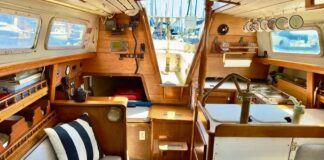Once considered a frivolous luxury for larger sail boats and motoryachts, the new breed of electric heads are generally more compact, more reliable, and less expensive than their predecessors.
Manufacturers are offering multiplying models and options for both the marine and RV markets. For boats currently fitted with manual heads, an upgrade is not beyond the capabilities of a competent do-it-yourselfer.
Electric toilets have another advantage: the automatic electric macerating pumps do a better job of efficiently eliminating waste, especially for the landlubbers and guests who don’t know whether they should pump once, twice, or sixteen times.
Any toilet upgrade must take into account plumbing details, but a conversion to electric also entails additional power requirements, wiring details, and over-current protection. Operating for only a few seconds per flush, the electric-pump toilets reviewed here, will not add a great deal to the daily amp-hour loads of a cruising boat. However, the momentary loads of electric pump and macerators can be as high as 30 amps, a demand-surge that can have consequences if the house battery bank is low or the electrical system is not designed to accept such loads. There is more than a grain of truth to the sea yarn about the autopilot that took a sharp turn to port every time someone flushed the toilet.
When installing a new toilet, follow the instructions carefully as to wire size and discharge sanitation hose size and length. Most boats will have a inch through-hull seacock valve as the inlet for raw-water flushing. For the outlet, a 1 outflow hose will usually lead to a lockable Y-valve that diverts flow to either a holding tank or directly overboard through a seacock. (The Y-valve must be locked or sealed in sensitive areas designated as No-discharge Zones.)
There are dozens of electric toilets of different models depending on size, weight, style, voltage, color, function and features. Several models are available in different iterations. They can come with or without separate inlet water pumps, macerator pumps, solenoids, or electronic control boxes. Some come with a simple push-button or a more elaborate multi-functions remote-control panel, with separate buttons for filling and flushing. Some are Spartan compacts; others are very stylish household types. Prices range from $429-$9,999.
For advice on choosing the best marine toilet for your boat, purchase and download Marine Sanitation Systems, Volume 1 – Marine Toilets today!








































